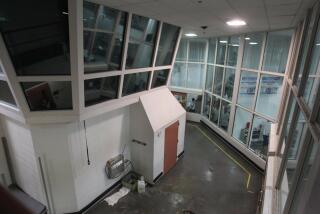Cocaine Caused Bias’ Death, Autopsy Reveals : Dose Said to Trigger Heart Failure; Criminal Inquiry to Be Pressed
- Share via
BALTIMORE — University of Maryland basketball star Len Bias died of “cocaine intoxication” after ingesting an unusually pure dose of the drug that stopped his heart within minutes, Maryland’s chief medical examiner said Tuesday.
Dr. John E. Smialek attributed Bias’ death last Thursday morning directly to cocaine, “which interrupted the normal electrical control of his heartbeat, resulting in the sudden onset of seizures and cardiac arrest.”
The 22-year-old Bias “was a very healthy individual” who showed no evidence of heart disease, Smialek said at a crowded news conference here Tuesday afternoon.
Smialek said there were no indications that Bias had used alcohol or taken any other drug in the hours preceding his collapse in his Washington Hall dormitory suite on the College Park campus.
He said that the autopsy conducted on Bias’ body showed no evidence that Bias was a long-term user of cocaine and that it was “possible” that the fatal ingestion was the All-American’s first encounter with the drug.
The autopsy revealed that the drug taken by Bias was unadulterated, indicating that he had obtained “dealer-level quality” cocaine, said Howard Silverman, acting head of the state Drug Abuse Administration.
“You’re not going to stop on the street corner and get that quality,” Silverman said. “You’d have to be pretty well connected.”
The autopsy report resolved the uncertainties over the cause of Bias’ death, leaving it up to a county grand jury investigation launched by Prince George’s State’s Atty. Arthur A. Marshall Jr. to determine the circumstances leading to the athlete’s collapse.
Marshall said Tuesday that the medical examiner’s finding “makes (the investigation) stronger relative to getting a manslaughter charge.”
Any charge would hinge on who brought the cocaine into the room, Marshall said. “Until we know that, everything is speculation. For all we know, it could have been Len Bias. We just don’t know.”
Marshall has said that the county grand jury will begin issuing subpoenas next week for teammates and friends who were with Bias in the hours before he died. The prosecutor said basketball coach Lefty Driesell is likely to be asked to testify.
Two dormitory mates, players Terry Long and David Gregg, and a friend, Brian Tribble, were with Bias when he collapsed, according to statements received by the police.
“The three of them know what really went on,” said Maj. James Ross, head of the county police criminal investigations unit. Police have sought unsuccessfully to question them. Marshall said Monday that “it appears that Long and Gregg didn’t bring drugs into the room.”
Bias’ other dormitory mates, basketball players Keith Gatlin, Jeff Baxter and Phil Nevin, said they were asleep when Bias collapsed and that they woke up to find paramedics trying to revive him in Long’s bedroom.
Marshall said that police found the dormitory suite “sanitized” when they searched the rooms shortly after Bias was pronounced dead at Leland Memorial Hospital in Riverdale at 8:50 a.m. EDT
A plastic bag containing approximately 12 grams of cocaine was found in Bias’ leased Nissan 300ZX, and Marshall said police found cut straws used for snorting cocaine, some cocaine crystals, a cognac bottle and several beer bottles in a trash bin outside the dormitory.
The state medical examiner’s office is analyzing the cocaine found in the car to determine its purity.
University Chancellor John B. Slaughter said Tuesday that the university will cooperate fully with the grand jury investigation. “We want to get to the heart of what happened to crush out the life of this young man at his very prime,” Slaughter said. “We are determined to learn what happened.”
Driesell could not be reached for comment.
Though Smialek said it was impossible to determine how much cocaine Bias took, Dr. Yale Caplan, toxicologist for the state medical examiner’s office, said in an interview later that Bias had taken a “high dose” of the drug.
The dose of cocaine that killed Bias would not necessarily have been fatal to another person because reactions to the drug differ widely, Smialek said. In comparison with other cocaine-induced deaths investigated by his office, Smialek said, Bias had “an average level of sensitivity” to the drug.
Smialek said Bias went into seizure within “seconds or minutes” after ingesting the cocaine, and that only rapid medical intervention--including cardiopulmonary resuscitation “by skilled professionals”--could have saved him. “It only takes four to five minutes for irreversible brain damage to occur,” Smialek said.
Smialek said it was not possible to pinpoint the time when Bias’ heart stopped beating. Asked if a 15-minute delay in summoning paramedics to Bias’ dormitory could have cost Bias his life, Smialek replied: “Possibly not.”
Marshall said Monday that 15 to 30 minutes might have elapsed between Bias’ collapse and the time an ambulance was called. One of the attendants who worked on Bias in the dormitory said that, based on Bias’ body temperature, it appeared that he had collapsed about 10 to 15 minutes earlier.
Paramedics called by Bias’ roommates at 6:32 a.m. arrived four minutes later. According to some accounts, Long was attempting to perform CPR when they arrived.
Smialek said, “It is not unusual to be unable to restart the heart” under such circumstances, and added: “If he had had medical attention within four to five minutes, it’s possible that something might have been done. But I couldn’t say he absolutely would have been able to be saved.”
More to Read
Go beyond the scoreboard
Get the latest on L.A.'s teams in the daily Sports Report newsletter.
You may occasionally receive promotional content from the Los Angeles Times.










